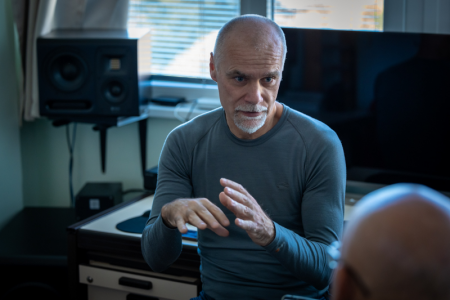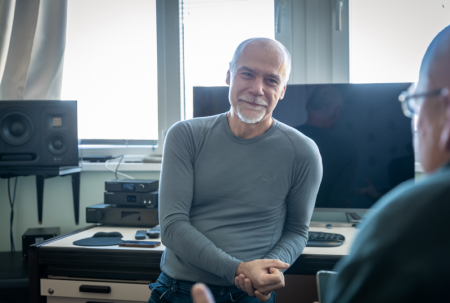
Few gene changes made the human brain creative - Prof. Dr. Gábor Tamás on the results of the brain atlas project
The human brain consists of 86 billion neurons and the same number of non-neuronal cells. The research consortium Brain Initiative Cell Census Network (BICCN), launched in 2017, set out to map the neurons of this biological system, compare them with the brains of nonhuman primates, examine the dynamics of brain development at the cellular level, as well as the functional analysis of human cell types. In the autumn of 2023, the giant project referred to as the Manhattan Plan for brain research published results that will determine the future research of the brain at the cellular level in selected publications in the journals Science, Science Advances, and Science Translational Medicine.
Among the lead authors of 3 of the 24 articles in the Science compilation is Dr. Gábor Tamás, head of the Hungarian Academy of Sciences-University of Szeged Brain Neuron Networks Research Group, professor of neuroscience at SZTE, together with several fellow researchers from Szeged. Our conversation reveals where the evolutionary hotspots of the human brain are, what makes our brains human, what healing goals stimulate brain research, what advantages the diversity of connections in the human brain brings, and why it is worth sleeping in the afternoon during the exam period.
– What comprehensive scientific picture of the development of the human brain do the publications of the BICCN brain atlas provide? Are there any surprises in the results?
– We received answers to fundamental questions about what distinguishes the human brain from that of nonhuman primates. With our American and European colleagues, we compared the brains of humans and their primate relatives, the chimpanzee, the gorilla, and the macaque. The publications record the results of this brain mapping research, primarily asking the question of what is in the human brain, what is in the brain of a nonhuman primate, and how different the two are. Are they different planets or just different continents? The answer is that they are not different planets, but indeed different continents. We found that there are brain neurons and connections that are unique to humans, and although these results were expected, it is still important to note that evolution has progressed step by step, and despite the existence of brain neurons that are only found in humans, it is not true that the human brain is completely unique, and compared to us, everything is backward in evolution.
– After all, what makes the human brain human? What percentage of brain neurons are found only in humans?
– There are approximately 150-200 types of nerve cells in the cerebral cortex, and in 10-15 percent of these we see that they are either significantly overrepresented in humans or perhaps specialized for humans. The first neuron type unique to humans was discovered by our research group a few years ago together with American colleagues. We named it a rosehip neuron after the shape of its axon endings, which was one of the first-generation results of the creation of the brain atlas. In that research, the question was whether there is a type of nerve cell that occurs only in humans or in humans rather than in rodents. We were able to show that, compared to rodents, there are indeed cell types characteristic of humans. One of our current articles went further and showed that even compared to primates, there are cell types that are overrepresented in humans, but the number of those that really only occur in humans is very minimal. There is a chance for this in the case of 1-2 percent of the mentioned 150-200 types of nerve cells, and these cell types occur relatively rarely and in few places in the brain. Their occurrence can also be examined according to brain areas. If we take a sample from the evolutionarily new part of our brain, the frontal lobe, and another from a very conservative part, such as the olfactory cortex, it turns out that conservation is significant in the latter area, and there is no difference in the brain cells here compared to nonhuman primates. However, the frontal lobe, which is strongly dominant in humans, is so new in evolution that there was no need for the appearance of new cell types. Evolution quite simply used quantitative tools to ensure this progress.

Dr. Gábor Tamás, professor of neuroscience at SZTE. Photo: Ádám Kovács-Jerney
– What caused cell types to become specialized in the brain?
– Between two species of animals, a significant difference in the brain is usually caused by which sense organ is dominant. In rodents, the visual system is not dominant — as is the case with us — but the olfactory system and whisker touch, as they use this to navigate in dark tunnels. Therefore, rodents have developed characteristic types of nerve cells that are responsible for whisker touch, for example, in the cerebral cortex, while the visual cortex is less developed compared to primates. From the results of recent publications, we also see that in primates, including humans, the visual cortex is the one on which evolution works intensively. Specialized new cell types that have not been seen elsewhere occur there.
– Where is the hotspot in the human brain where evolution has changed the most?
– It seems that it is not a hotspot, but rather a hot cortical layer. In addition to the above-mentioned brain regions with increased areas, we noticed that regardless of the brain area, evolution works mostly in the outermost, so-called layer 1 of the cerebral cortex. The diversity of new cell types in this layer has given human neural networks functional capabilities not available in other mammalian species. This layer of cells is an evolutionary hotspot, where changes reflect the higher demands of controlling more complex brain circuits in humans.
– Where does the development of the human brain lead in the Information Age? Does it stop developing the conservative part, which already fulfills its function properly, and start adding new parts?
– Evolution is dynamic, a function never stays the same. I don't know when, but if we continued like this, sooner or later our brains would have cells specialized for mobile phones. If our environment were to develop at this rate in the direction of having a body part outside the body, then it would also have a representation in the brain. Meanwhile, of course, there would be no trace of this in the other species. Let me give you a simple example of the effect of the environment. Cetaceans see very differently than we do; our vision requires light, and theirs requires sound. They perform the same function, the identification and tracking of food, sources of danger, and animals moving independently in the environment, with different means than terrestrial species. Such a set of tools is an evolutionary constraint for the brain, which will of course lead to ad hoc solutions. Neuroscientists call the way an object is mapped in our brain an immediate cortical representation; if this object appears anew, like the mobile phone in our hand, we can't put it on the right shelf of our brain library at first, but sooner or later a completely new shelf will be formed, where the extra information will fit nicely.
– Are there new skills involved? Maybe a different representation already characterizes frequent mobile users?
– Yes, skills are also developed this way. This adaptation is also present in the nervous system at the level of the individual. A fellow human living in Stone Age conditions may have a different representation than a person living in modern conditions. However, the evolutionary specialization and technology are not yet able to detect them. There is probably no type of nerve cell characteristic of an individual, and such studies would also have ethical limitations. So for now, it can be said that different individuals have a very similar brain map if we take the number and types of neurons. The brain contains not only neurons, but also so-called glial cells that support neurons, but these can be considered even more conservative than neurons. As evolution progresses, the novelty appears to be the variety of nerve cells.

Photo: Ádám Kovács-Jerney
– Are there no differences in brain neurons within groups of people?
– This is the research program for the next five years. In the brain atlas project, with the research so far, we tried to draw a conclusion at certain points about the differences between humans, as a homogeneous species, and primates, i.e. chimpanzees, gorillas, macaques, or marmosets. The financing of the next five-year program was decided before last year by the National Institutes of Health (NIH), the American state organization that finances biological research, which finances the world consortium BRAIN Initiative Cell Census Network. Only a few groups from Europe participate in this; the main reason for inviting our research group is that 15 years ago, essentially, with our help, the human brain slice method was implemented at the Allen Institute, which brings together brain atlas research. They took over our technology and then we used it together for the first time, and as a result, we found the first type of nerve cell characteristic of humans, the already mentioned rosehip cell.
The next 5 years will therefore be about how big the difference between genetically heterogeneous groups of people with different social backgrounds is at the level of brain cell types, and at what level the differences between the main human races can or cannot be noticed in the structure of the cerebral cortex. We primarily investigate whether we see differences in the structure of cell types or variations between individual cells. This is research on a finer scale, and I think it is also more ethically sensitive. There is a definite demand from the US government for this program to screen human populations of various backgrounds from this point of view.
– What is the purpose of exploring the differences between different human races? What will be your most important research goal in the upcoming period?
– For me, it is to establish treatment procedures that can later be applied clinically. A few years ago, we found some cell types that are characteristic of humans and do not occur in rodents, and are selectively susceptible to Alzheimer's disease, meaning that they die earlier than other nerve cells as a result of the disease. As a result, it is very difficult to model Alzheimer's disease in rodents, because they do not have the cell type that is especially sensitive to it. When it comes to researching the brain neurons of different groups of people, we also know of many other diseases that are linked to certain groups of people more than others. Certain types of dwarfs, for example, do not develop cancerous tumors, and we roughly know the reason for this. This property can be used to the advantage of other groups of people, it can be the basis of a treatment that makes others cancer-free. It can also be found in psychiatric illnesses, and we may have a chance to find an explanation for it. The same logic can be used to achieve results in a system more complex than the cerebral cortex. Even the description of neuropsychiatric diseases is problematic in certain cases, and it is very difficult to define something without knowing its essence. Today, we usually define some neuropsychiatric diseases not based on their biological explanation, but on an experiential basis. A group of highly experienced clinical doctors defines the symptoms based on which we pronounce the disease. To make more accurate diagnoses, we also want to learn about the biological basis of neuropsychiatric diseases.

Photo: Ádám Kovács-Jerney
– It is confusing that 86 billion neurons work in our brain. How diverse are these?
– The mapping of neurons was primarily based on the gene expression map of a specific neuron type and how different it is from the closest similar neuron. There are roughly 30,000 genes to choose from, of which 15,000 to 16,000 are actively used by a cell, no matter where it is in our body. Cells can be grouped by which of the 15-16 thousand genes that work in a given cell type, while another 15-16 thousand are in use in another, and there are 3-4 thousand gene differences between the two. There are many different ways to choose from thirty thousand, and I think it's really surprising that despite this, we only have a few hundred and not a few tens of thousands of types of neurons. However, this is only the first layer of diversity, examined at the level of neurons. Consider that genetically extremely similar people can speak completely different languages. Just as language is the channel of communication, neurons also differ in order to be able to maintain communication in different ways. In higher-level nervous activity, the essence of their existence is communication within the nervous system. However, the connections between human nerve cells can be arranged in so many different ways that the number of elementary particles in the known universe is far behind, by several orders of magnitude. The number of combination possibilities is therefore - it is not scientific what I'm saying now - almost infinite, and despite this, the organization of the nervous system does not follow any, but very specific choice directions. We now see that these choices in evolution are formed step by step from one animal species to another, so there are no radical changes at the level of the map of brain neurons. However, at the level of behavior, that is, in how we use this brain map during behavior, how we navigate the map of cell types, and which element of the map will be important to us - there can be really radical changes. With a very limited set of tools and very small changes, enormous operational heterogeneity, creativity, and precision can be achieved in a given life situation or for the purposes that are important to a given animal species. In other cases, if this is not necessary, we simply stay with the basic operation and do not use the possibilities of the brain. In the case of humans, there are life situations in which these connections can change even during our lifetime, namely in such a way that we lose certain characteristics and skill sets, and we use certain ones, even depending on age.
– Can the deciphering of behavior be expected from the research of networks between brain neurons?
– The network operation of neurons is the area where the research frontline is even further behind compared to what should be achieved. This current work was about the types and diversity of individual neurons, but how they form networks is only discussed in 1-2 works out of the 24 articles. In this area, brain research still owes a great deal to understanding what organizes individual neurons into functional neural networks. How the organizing elements, which we know in general terms, participate in behavior, decision-making, and intelligence. We don't know, for example, whether a particular type of nerve cell is involved in raising IQ from 100 to 120 in humans, or from 30 to 50 in a nonhuman primate.
– You previously stated that behavior-related networks can also be studied in humans; has this happened yet?
– Unfortunately, I cannot talk about this yet due to the rules of the research project. I hope next year!

Photo: Ádám Kovács-Jerney
– The brain atlas also indicate that in today's brain research, nerve cells are studied at the molecular level. Can you give an example of what conclusions can be reached in this way?
– In our article dealing with the functioning of nerve cells, we studied the function of an actively functioning gene in a nerve cell. This article is one of the few publications in the compilation of Science magazines that does not deal with the mapping of neurons but with their functioning. We started to research the basic property that an actively functioning gene in the cell is sooner or later translated into proteins, and then the protein can go to different places within the cell. Nerve cells differ from other cells in our body in that their morphology is extremely complex, they can have many different shapes; unlike our other polyhedral cells, neurons have plant-like extensions. In this extension system, the proteins are placed in their place in a controlled manner. Let's stick with the plant analogy: it is natural for everyone that there are no leaves on the root, the proteins that a tree uses in its leaves are not needed in its roots. We have found that in the case of neurons, this is the case, and at the same time it is not. It turned out that a protein that - to use the analogy of the tree - was thought to be expressed only in the leaves or mostly in the leaves, is also needed in a completely unexpected place, at the end of the root, but for a completely different function than we thought so far. So, using the same set of tools, and placing the same protein in a different region of the cell, the same cell can achieve radically different functions. An experiment observed on human cells led us to this conclusion; I highlight this because there are phenomena that are easier to notice in a human neural network than in an animal one. Since we have spent most of the last 20 years mapping the properties of human brain neurons, we already have enough experience to select the questions that are really worth investigating in humans and not in animal models.
– What is the research specialty of neuroscience conducting neuroscience tests on human samples?
– The experimental technology is very similar to what should be used in the study of an animal model. However, the fact that the tests are conducted on a human sample makes it significantly more difficult. Animal models are usually chosen by researchers because they are easy to work with, as the model is optimized for the experiment. Here, however, we cannot optimize samples, but we are only grateful to those fellow human beings who decide that we can use their surgically removed brain tissue for research purposes. We work with what we get, we can't be very picky about what the pattern should be. The advantage and disadvantage of this is that few researchers work with non-optimized human samples because it is difficult to do so. In addition, it is not enough for someone to be a professional in an experimental procedure, for neurophysiological tests they usually have to have manual skills too. It is a multi-skilled job: a researcher has to know procedures from electronic instruments to biophysics, including delicate surgical procedures, and this is as much a manual challenge as it is a mental one. The combination of these two is not very common.
– I saw neurosurgeon Pál Barzó among the authors of the Science publications...
– He too works like that: the more difficult a research is, the more willing he is to do it. We met almost twenty years ago, in 2004 we submitted our first ethical application to conduct these experiments, and since then we have been working in close cooperation. It was by chance that we met; at the time, they accepted an award together with my wife, who is also a doctor, and on the way home they talked about what each other's family members were doing. I can safely say that without him we would not have achieved such results in Szeged. I don't even know if there is another colleague in my career to whom I can thank as much as him.

Photo: Ádám Kovács-Jerney
– Can there be many types of connections between neurons? I listened to your 2017 lecture at SZTE, from which I learned that human brain synapses are more intense than animal synapses and that this strength can even be scaled.
– From the fact that the human brain is larger, it also follows that it can be scaled and has become more diverse than the small animal brain. Think about the fact that there are many different answers to a question, while only two types of answers to a yes-no question. This is the difference between a standard animal synapse and a human synapse. The animal synapse provides answers to questions to be decided, in an animal brain environment this can only have two outcomes. The human synapse, on the other hand, can give a diverse answer to the same question. This is a fundamental information-rich difference between our networks and, say, a rodent's. The potential for diversity is therefore much greater in a system that uses a wider set of tools.
– Does this also appear in the fact that human memory has even greater reserves than previously thought?
– Here, the experiments come up again, which I cannot talk about for the time being. The main question of the next five years is what these scalable synapses cause in the decision-making, representation, and memory of behaving people. I hope we will be talking about this in five years.
– Do you think it is possible that software using artificial intelligence can be connected to the human neural network?
– There is already a relatively serious literature on connecting software and the brain. When we talk about the brain-computer interface that connects the two, we have to consider the complexity of the systems on either side of the interface. We know one of them, the machine, almost completely, we have blueprints for it, and we understand its properties; however, the side of the brain is known only in outline. Like this, it is very difficult to create a user interface. We are lucky that the brain is versatile and overdesigned, able to perform the same function in countless ways, unlike a human-designed and fully controlled machine. Because of this, the living part can adapt to the nonliving. There are serious initiatives that would grow, for example, neural networks according to a circuit diagram. Otherwise, a single neuron can be connected to the interface; a single neuron can be almost compared to a processor, and it is not necessary to create a complete neural network for it. Because the nerve cell receives input from tens of thousands of other cells, which is then processed by a single nerve cell acting simultaneously as an analog and digital computer. This neuron cell will have some output that can be connected back to the artificial part. So it shouldn't be a problem to somehow connect the output of human neurons to the interface. This output is practically a series of electrical signals that we can detect and interpret with artificial intelligence. For example, by giving it a code, like in Morse code: we hear the same sound there, just in a different rhythm, and through the code we know what they want to say with it.

Photo: Ádám Kovács-Jerney
– You and your research group previously proved that it is possible to repeat previously heard information even during sleep when the brain cells are in an inhibited state. Does this mean we learn while we sleep?
– Repetitio est mater studiorum goes the classic saying, and we really do this even when we sleep. Information comes in during the day, and parts of it that are relevant, important, interesting, or arranged according to some other aspect are replayed in our nervous system during sleep, and thus the neural network activities that have been practiced once before are run over and over again. With repetition, we can almost burn the information into these very fluid, dynamically changing connections. If we learn a lot and use it more often, the routes with "lots of trucks" will be strengthened. Our already mentioned Science publication dealing with the functioning of nerve cells is also connected to this function; in this, it was revealed what hitherto unknown process leads to the fact that nerve cells can still be brought out of this highly inhibited state during sleep. The key role in this is played by the protein, which is not released in the usual place, but instead is placed by the nerve cell in an unexpected, hitherto unknown place. With the help of this mechanism, a group of our neurons can activate itself and others during sleep.
– So can the students sleep peacefully during the exam period?







